There is a lot of speculation happening during these weeks about the possibility that Kate Middleton will wear the Spencer Tiara on the day of her wedding to Prince William ofEngland. A few days ago, even the magazine “Hola” dedicated an interesting coverage to the famous tiara.
Since Princess Diana’s death the jewel has not been seen in public, remaining in the hands of its current owner, Count Spencer in “Althorp House”, where one can admire it in all its splendour.
This magnificent jewel has not been worn as a tiara for all that long. Due to this, one cannot really consider it to be a family relic, as seen as its history is rather recent. The evolution of this piece starts in 1919 when Lady Sarah Spencer, the single sister of the sixth Count of Spencer, gave a beautiful piece of jewellery to her niece in-law, Cynthia, as a wedding gift to her marriage with Albert Edward. Cynthia and Albert would later become the seventh Counts of Spencer, and Lady Diana’s grandparents (on the paternal line).
This jewel, which would be received by Diana’s grandmother as a wedding gift, was a sparkling piece in the shape of a tulip, and it would be the part that would later become the central piece of the famous tiara.
However it wasn’t until 1937 that the tiara was really converted into the jewel that we know today, and that many years later would be sported by Lady Diana. This year, four more elements were added by the prestigious English jeweller Garrard. We know that the cost of this alteration was 125 sterling pounds at the time.
Coincidentally, that same year and in the same jewellers, Queen Elizabeth II subjected the Imperial Crown that she would wear on the day of her coronation, to a few alterations. Would the two tiaras coincide in the hands of the same goldsmith during those days?
Only the two small elements that were decorated at the end of the tiara were truly antique. It is believed that they belonged to a tiara from the French Viscount of Montagu, and that they were inherited by Lady Sarah Spencer in 1875.
It doesn’t seem logical that such a significant day in the English Monarchy’s history, such as the wedding of its future King, the Queen of England would favourably view the fact that the Bride displays a jewel that doesn’t belong to the British crown. It seems fit to wait for the opposite to happen, that the Queen would give one of her magnificent tiaras as a gift to the future wife of her beloved grandson. There by the bride that would one day succeed her as the Queen of England would wear one of the pieces from the Royal House’s collection on such an important occasion.
In the supposed case that William would desire to pay a posthumous tribute to his mother, he would be obliged to ask his uncle for the loan of this famous tiara, as seen as the current Count of Spencer is its legitimate owner.
William had wanted to have his mother present when presenting Kate with the same engagement ring that Lady Di received from the hands of his father on the day of their engagement in February 1981. The jewel is a magnificent ring, with an oval-shaped 14 karat Ceylon Sapphire with a surrounding halo of 14 shining stones, mounted over white gold by the famous jewellers, Garrards. This jewel was chosen by Queen Elizabeth and her son Charles for the significant date. Its price was 28000 sterling pounds.
The Spencer tiara is a truly dignified jewel for a Queen, however it is also true that perhaps Lady Di’s controversial figure should allow Kate to be the protagonist on an occasion this important, if it is finally decided that the same tiara is to be worn as on the day of her wedding.
What would you do?


